What does Swiss chard look like and how to grow it?
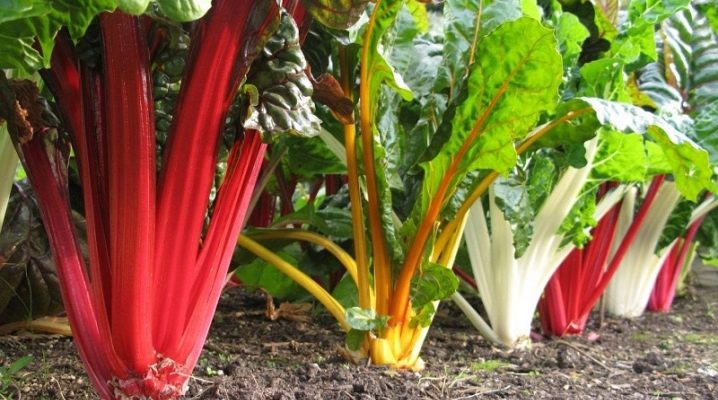
Mangold is a tasty and very healthy vegetable, which for some reason is not particularly popular in Russia. However, its cultivation does not cause any particular difficulties, and therefore can be carried out even on the windowsill.

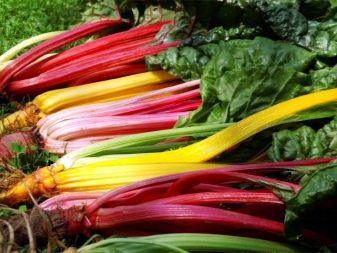
What is this plant?
Chard, also referred to as leaf beet, is a herbaceous biennial, a subspecies of common beet, a representative of the Haze family. This vegetable generally looks the same as its "beet" relatives, but with its elongated stems and leaves it resembles spinach. The main difference from the usual beets is that they eat not the root vegetable, but the tops of the plant: thick crispy petioles and smooth leaf blades. These greens taste like asparagus or cauliflower. It is worth mentioning that the color of the petiole can differ depending on the variety - be white, yellowish, bright red or different shades of green. Leaves, up to 30 centimeters long, grow straight or curly.
The biological description of chard indicates that the root of the plant is thickened and often branched, and it does not form a root crop. In the first year, the biennial forms a powerful leaf rosette with petioles up to 25 centimeters high, and in the second year it throws out a coarse ribbed stem with peduncles, which allows collecting seeds at the end of the season. The flowers of chard are small, painted either white or green. The buds gather in glomeruli, which, in turn, form elongated inflorescences. The flowering of the culture occurs only in the second year of the plant's life, from May to September. The fruits of the beet are nuts, which form ball-shaped fruit and ripen by September.
In cooking, chard is mainly used in the preparation of salads, appetizers, first courses, in many national cuisines. In addition, vitamin beet is used for medicinal purposes.

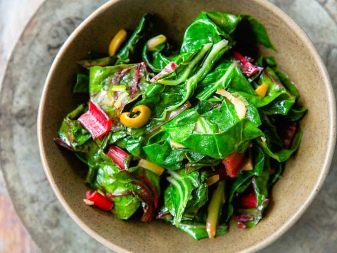
Varieties
Several varieties of chard are recommended for growing in the garden and at home. It should also be mentioned that they are all divided into leaf and petiolate. There is no particularly noticeable difference between them, but the former still have a strong rosette with plates 20 centimeters long, and the latter form more massive and dense petioles. And also leaf chard ripens in 50-55 days, and petiolate - after 75-80 days. So, one of the best varieties is considered "Swiss red", which can be sown from mid-April. The plant develops very quickly, and after 40-45 days the first portion of the crop is harvested. This beet is characterized by a very large rosette, which must be thinned out as it grows.
A variety of lettuce beets called "Emerald" ripens rather slowly: from the moment of sowing the material and pecking the seedlings to the first tasting, you have to wait at least 2 months. This variety has compact rosettes and dimensional elastic petioles. Chard "Yellow" is a mid-season variety. A powerful upright rosette is made up of dark green leaves 20-25 centimeters long. The petioles, reaching a length of 25-30 centimeters, have a bright yellow color. For the variety "White Silver" snow-white, very juicy petioles are characteristic, and in "Rhubarb" chard, these parts are painted in a bright beetroot color.
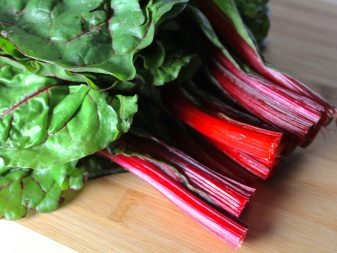
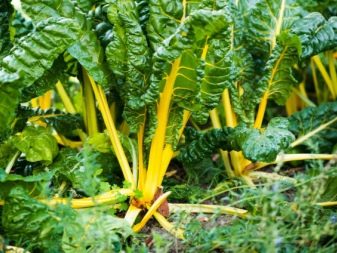
Landing
You can plant chard both in open ground and indoors (in a greenhouse or greenhouse). It is also possible to breed this culture at home. Sowing is usually carried out in the spring, when the soil temperature warms up to +5 degrees, and the air temperature reaches +18 degrees. In the southern regions, similar conditions occur in early April, and in the rest - from early to mid-May. Some gardeners choose to repeat sowing in mid-July and late October. Sowing seeds or planting seedlings is recommended in well-lit areas. Chard loves fertile loams with neutral acidity.
The soil in the beds is prepared in the preceding autumn. For this purpose, the earth is dug up with a deepening of 25-30 centimeters, after which it is fed with a nutrient mixture. To process each square meter, you will need to use 5 kilograms of matured manure, 20 grams of superphosphate and 15 grams of potassium chloride. If it is necessary to reduce the acidity, lime or dolomite flour is added to the bed. Upon completion, the soil is loosened and freed from lumps. In the spring, loosening must be repeated, and then add 10 grams of ammonium for each square meter. The best precursors for chard are nightshades, cucumbers and carrots.
Seeds of leaf beet are pre-sorted and evaluated for suitability, for which they are filled with water and freed from floating specimens. For disinfection, the material will also need to be soaked for a couple of hours in a manganese solution or for an hour in potassium permanganate and for the same time in a stimulating preparation. Sowing of seeds is carried out in 3-4 pieces in pre-dug grooves. A space of 40 centimeters should be maintained between the depressions, and between groups of seeds - 15-20 centimeters... The material deepens by no more than 3 centimeters. The procedure is completed by mulching the beds with sawdust or peat.
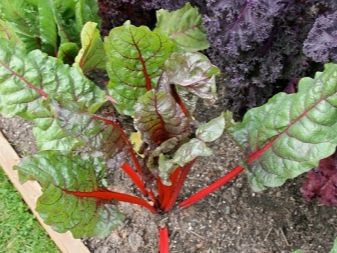

Growing care
When growing chard outdoors in the middle lane, the Moscow region and the Urals, it is recommended to cover the plants during spring return frosts so as not to provoke early flowering. For the same regions, it is preferable to first grow seedlings from seeds and get rid of weak seedlings during a pick.
Watering
Mangold growing in the garden should be watered 1-2 times a week with light rainfall, and on dry, dry days - up to 3-4 times a week. If precipitation fell 2-3 times in 7 days, then leaf beets are allowed not to irrigate at all. For the procedure, it is customary to use a settled and naturally warmed liquid.

Top dressing
To prevent the plant from accumulating nitrates, it should be fed with humus, herbal infusion, diluted mineral fertilizers or wood ash... Before applying liquid fertilizers, the bushes are watered so that for each there is at least 1 liter of water. Wood ash is scattered over the garden bed even before irrigation. It is recommended to feed the crop every time after cutting the tops.
It should be mentioned that At home, chard can also be grown on a glassed-in balcony or on a windowsill. To this end, the roots are dug out of the ground in the fall and transplanted into small pots, which are then illuminated and irrigated. You can also sow the crop immediately in containers that will be kept on the south or west side of the apartment. Basically, a home culture only needs watering twice a day and enough light.
When cultivated in a greenhouse, the bushes are fed with diluted fertilizers and moistened every 7 days.

Diseases and pests
Leaf beets are often affected by powdery mildew, while young leaves and petioles are affected. To fight the disease, it is not recommended to use chemicals.... It is better to pay sufficient attention to prevention: at the stage of 2-3 leaves, add potassium-phosphorus fertilizers and carry out treatment with drugs that strengthen the immune system.To directly deal with the disease, you can spray the plant with 1 liter of whey diluted in a bucket of water.
Of the pests, the culture is most often attacked by beet aphids and earthen fleas. You can cope with aphids in the folk way: finely chop about 300 grams of onions and insist it for about 2 days in a bucket of water. Before spraying, the mixture must be filtered.... To combat insects, you should also pollinate the beds with a mixture of wood ash and tobacco dust.
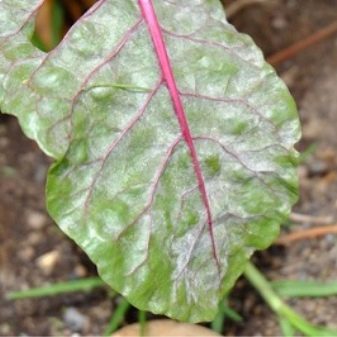

Harvesting
Harvesting can sometimes be carried out as early as one and a half to two weeks after sprouting. And this time, and in the future, the most dimensional extreme leaves are to be cut, regardless of whether they are required or not. If the records outgrow, they will lose their taste and juiciness. You cannot tear off the sheets - you should cut them off with a sharp and clean knife... It is recommended to use only fresh specimens for food, the surface of which is not damaged by dots or spots. Chard is able to grow almost until the end of autumn.
There are two ways to save the harvest. Freshly cut plates and petioles are laid out in transparent bags and put into the refrigerator. You can keep them in this state for a maximum of 3-5 days.
You can also rinse the chard, cut it into small pieces, put it in bags, and put it in the freezer.
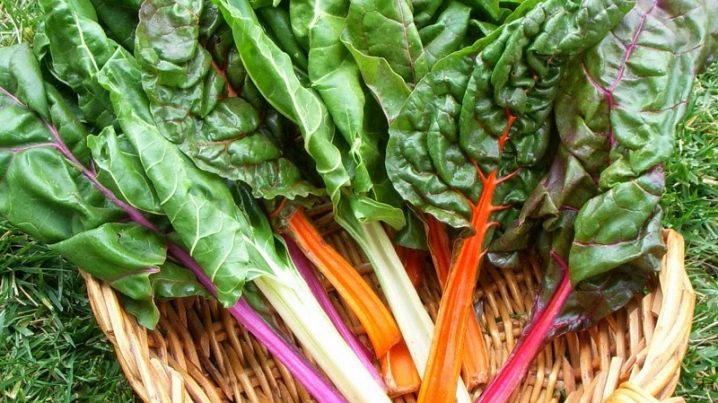












The comment was sent successfully.